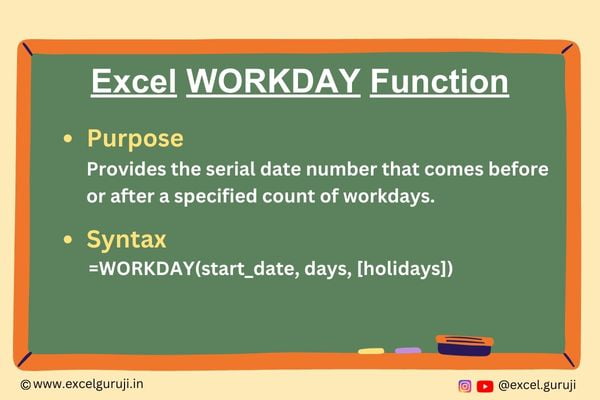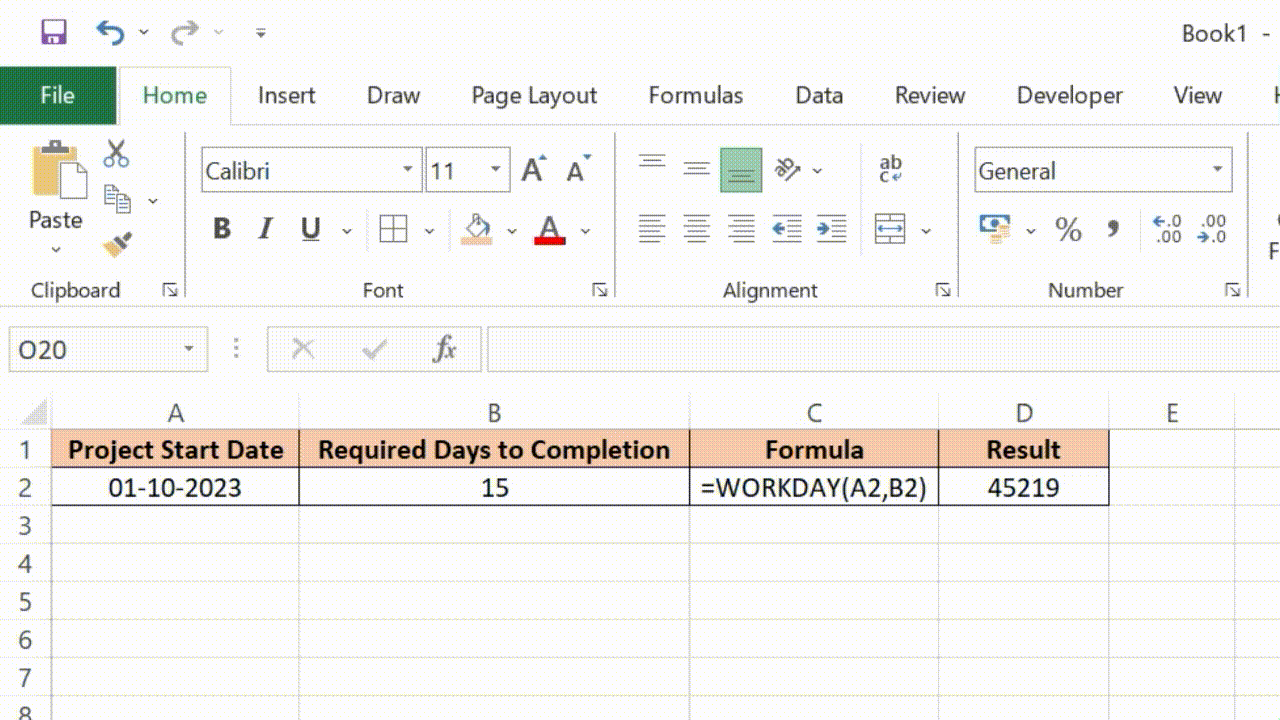Contents
Excel WORKDAY Function

When to Use the Excel WORKDAY Function in Excel
Excel WORKDAY function is used in scenarios where you want to calculate a date that falls a certain number of workdays ahead or behind a given date. This function is commonly employed in business and project management to schedule tasks, estimate delivery dates, and manage project timelines.
What Excel WORKDAY Function Returns
Excel WORKDAY function returns a date that is a specified number of workdays (business days) ahead or behind a given start date. It allows you to skip weekends (Saturdays and Sundays) and optionally, any specified holidays, making it a valuable tool for accurate date calculations.
Syntax of Excel WORKDAY Function
The syntax of the Excel WORKDAY function is as follows:
=WORKDAY(start_date, days, [holidays])
Input Arguments
Here are the input arguments for the Excel WORKDAY function:
● start_date: This is the initial date from which you want to calculate the workdays. It can be a reference to a cell containing a date or a direct date entry enclosed in quotation marks.
● days: The number of workdays (positive or negative) you want to add or subtract from the start_date. This argument can also be a cell reference containing the number of days.
● holidays (optional): This argument is not mandatory. You can provide a list of dates (range or array) that represent holidays when work should not be considered. If omitted, weekends (Saturdays and Sundays) are the only days excluded.
Extra Notes
● If you use a negative value for the days argument, the WORKDAY function will calculate dates in the past from the start_date.
● If your holiday list is subject to change, consider storing it in a separate range or table in your Excel workbook and referencing that range in your WORKDAY function. This way, you can easily update the list without modifying your formulas.
● If any of the arguments is not a valid date, the WORKDAY function will result in an error, displaying #VALUE!.
● Additionally, if the addition of start_date and days results in an invalid date, WORKDAY will return the #NUM! error value.
● It is worth noting that if the days argument is not an integer, Excel will truncate it.
Examples of the Excel WORKDAY Function
Here are a few examples of how to use the WORKDAY function:
Example 1: Calculating a Future Date
Suppose you have a project that starts on October 1, 2023, and you want to know the date 15 workdays into the project. You can use the following formula:

This formula will return the serial number of a date. If you want to convert it into a date format, go to the Home tab, and then select Short Date or Long Date from the Number Format ribbon.

Example 2: Accounting for Holidays
In a business scenario where holidays are observed, you can include a list of holidays to ensure accurate calculations. For example:

This formula calculates a date twenty workdays from October 1, 2023, excluding all weekends and holidays.
Conclusion
In conclusion, the Excel WORKDAY function is an essential tool for handling date calculations in a business context. Whether you need to plan project timelines, estimate delivery dates, or manage work schedules, this function simplifies the process by excluding non-working days.
By mastering the Excel WORKDAY function, you can enhance your efficiency in Excel and improve your ability to manage time-sensitive tasks accurately.
Remember, Excel offers a wide range of date and time functions, so exploring and experimenting with them can lead to more efficient data management and analysis in your projects. Start using the Excel WORKDAY function today and take your Excel skills to the next level!
Frequently Asked Questions (FAQs)
Q1: Can the WORKDAY function handle negative values to calculate past dates?
A1: Yes, the WORKDAY function can handle negative values to calculate dates in the past by subtracting workdays from the start_date.
Q2: Can I use cell references for the start_date and days arguments?
A2: Absolutely, you can use cell references for both the start_date and days arguments, which makes your formulas dynamic and easily updatable.
Q3: Is it necessary to provide holidays as an argument in the WORKDAY function?
A3: No, it is not mandatory to provide holidays. If omitted, the function will only exclude weekends (Saturdays and Sundays) from the calculation.
Q4: Can the WORKDAY function handle regional date formats?
A4: Yes, the WORKDAY function is flexible and can handle various date formats based on your system settings, making it suitable for international users.
Q5: How do I calculate workdays excluding only specific weekdays, not weekends?
A5: If you want to exclude specific weekdays (e.g., Mondays and Wednesdays), you can use a Excel WORKDAY.INTL functions to achieve this custom calculation.
Other Related Excel Functions
Join me on Instagram, YouTube and WhatApp Channel for your daily dose of valuable tips and tricks! Catch insightful videos that will enhance your knowledge and skills. Don’t miss out – follow me now!